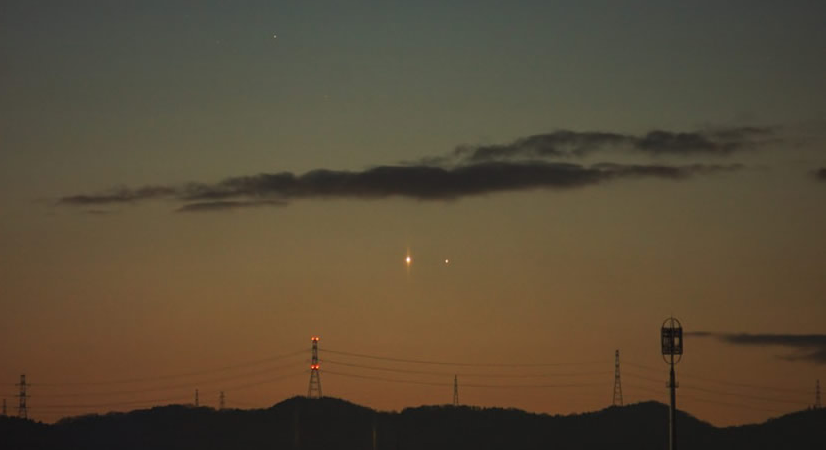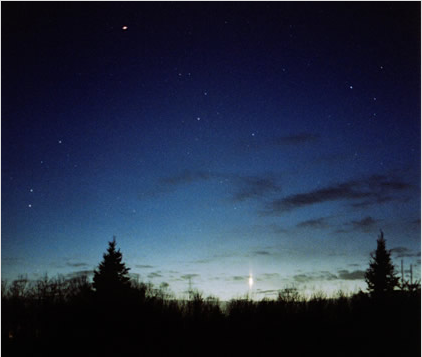Venus Pillars
Venus Pillars: A Rare Atmospheric Phenomenon
Venus, the second planet from the Sun, is known for its beauty and brilliance in the night sky. But did you know that Venus can sometimes produce a rare atmospheric phenomenon known as Venus pillars? These pillars are fascinating optical effects that create beams of light emanating from the top and bottom of the planet. In this article, we will explore the intricacies of Venus pillars, how to observe them, and what causes these captivating phenomena.
Understanding Venus Pillars
A Venus pillar is a rare event that occurs when light is scattered by ice crystals in the Earth's atmosphere. These ice crystals act as tiny prisms, bending and reflecting light to create vertical beams that appear to extend above and below Venus. The pillars can be seen when Venus is low on the horizon, just a few degrees above the Earth's surface, and when the sun is well below the horizon. The presence of a thin layer of cirrus clouds, often indicated by sundogs or a sun pillar at sunset, enhances the visibility of Venus pillars.
Observing Venus Pillars
To observe a Venus pillar, it is crucial to find a clear horizontal view of the sky where Venus can be seen at a low elevation. It is recommended to use low-power binoculars for better visibility, but never observe when the sun is visible. Faint and diffuse glows become more apparent when the binoculars are moved slightly back and forth. However, one must be cautious of false sightings caused by lens reflections.
Capturing Venus Pillars
Capturing an image of a Venus pillar is a challenging yet rewarding endeavor. The use of photography equipment, such as cameras with different lenses, can help document these unique atmospheric phenomena. In 2002, Carol Lakomiak captured what might be the first-ever image of a Venus pillar while photographing Comet Ikeya-Zhang. Her photograph revealed beams of light radiating from the top and bottom of Venus, which were more pronounced when observed through binoculars.
Factors Affecting Venus Pillars
Several factors contribute to the formation and visibility of Venus pillars. The brightness of Venus plays a crucial role, as it needs to be significantly brighter than surrounding celestial objects. The presence of other planets, such as Mercury, can provide a gauge for estimating the height of the pillars. Additionally, atmospheric conditions, including the presence of cirrus clouds and the angle of observation, can influence the clarity and visibility of Venus pillars.
Similar Atmospheric Phenomena
While Venus pillars are a unique and rare phenomenon, they share similarities with other atmospheric optical effects. Sun pillars, for example, occur when sunlight reflects off ice crystals in the atmosphere, creating vertical columns of light above or below the sun. Similarly, moon pillars can be observed when the moon's light interacts with ice crystals, resulting in vertical beams of light extending from the moon. These phenomena demonstrate the intricate interplay between light and atmospheric conditions.
Scientific Significance
Studying Venus pillars provides valuable insights into the behavior of light in Earth's atmosphere. By examining the formation and characteristics of these optical effects, scientists can gain a deeper understanding of atmospheric optics and the scattering of light by ice crystals. Furthermore, observing Venus pillars can contribute to our understanding of the composition and dynamics of the Earth's atmosphere.
Conclusion
Venus pillars are captivating optical phenomena that occur when light is scattered by ice crystals in Earth's atmosphere, creating vertical beams of light above and below Venus. To observe these rare events, one must find a clear horizontal view of the sky with Venus low on the horizon and the sun well below it. Capturing images of Venus pillars can be challenging but rewarding, providing valuable documentation for scientific study. By studying these phenomena, scientists can deepen their understanding of atmospheric optics and the behavior of light in our atmosphere. So, keep your eyes on the night sky, and you might just catch a glimpse of the mesmerizing Venus pillars.

Upper and lower pillars produced by Venus. Shinya Ueda imaged this pillared Venus at dawn on 11th January 2005 from Osaka, Japan. Mercury is 0.5 degree to the right of Venus allowing us to gauge the total height of the pillars as about 0.4 degree. Mercury (magnitude -0.3) was 20X less bright than Venus which accounts for why its pillar was too faint to show in the photograph. Image@2005 Shinya Ueda reproduced with permission.
A pillar produced by a planet is a rare event. To see one, first find a clear horizontal so that the planet can be seen when only a few degrees high and when the sun is preferably well below the horizon. A thin layer of circus is needed - perhaps previously indicated by sundogs or a sun pillar at sunset. Search for a Venus pillar with low power binoculars - but never when the sun is visible. Move the binoculars to and fro slightly because faint and diffuse glows then show up better. Be wary of false sightings caused by lens reflections!

Venus on 9th April 2002 imaged by Carol Lakomiak of Wisconsim. Carol was photograhing Comet Ikeya-Zhang when she noticed that Venus looked odd. "Without optical aid, I saw beams of light coming from the top and the bottom of the planet. They were more pronouced through 11x70 binoculars. I turned the camera to the west and began to take photos..."
This 15s, 50mm exposure might well be the first ever image of a "Venus Pillar".
Image@2002 Carol Lakomiak reproduced with permission.
Note: this article has been automatically converted from the old site and may not appear as intended. You can find the original article here.
Reference Atmospheric Optics
If you use any of the definitions, information, or data presented on Atmospheric Optics, please copy the link or reference below to properly credit us as the reference source. Thank you!
-
<a href="https://atoptics.co.uk/blog/venus-pillars/">Venus Pillars</a>
-
"Venus Pillars". Atmospheric Optics. Accessed on April 20, 2024. https://atoptics.co.uk/blog/venus-pillars/.
-
"Venus Pillars". Atmospheric Optics, https://atoptics.co.uk/blog/venus-pillars/. Accessed 20 April, 2024
-
Venus Pillars. Atmospheric Optics. Retrieved from https://atoptics.co.uk/blog/venus-pillars/.